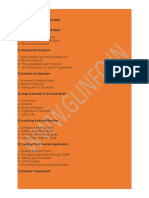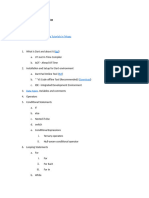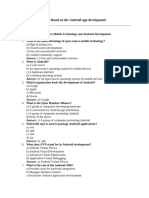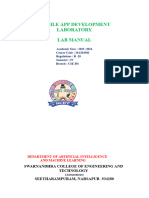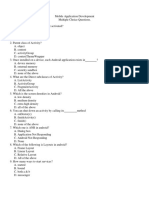Part 1:-Android - The Big Picture: 1. A) B) I) Ii) Iii) Iv) V) Vi) C)
Uploaded by
Vaibhav SharmaPart 1:-Android - The Big Picture: 1. A) B) I) Ii) Iii) Iv) V) Vi) C)
Uploaded by
Vaibhav SharmaPart 1:- Android The Big Picture
1.
Android Introduction
a) b)
The Evolution of Android Devices running Android
i) ii) iii) iv) v) vi)
HTC Models
Samsung Models Motorola Models Tablets Other Devices
c)
Hardware differences in Android devices i) Screens hdpi/mdpi/ldpi ii) User Input Methods iii) Sensors iv) Internal Memory
d)
Features of Android i) Multiprocess and Application widgets ii) Touch, Gestures & Multitouch iii) Soft and Hard keyboards
e) f)
The Android Platform Understanding The Android Market i) Mobile Operators & tech used (CDMA/GSM) ii) Android v/s the smartphones. iii) Androdi v/s itself.
iv) Licensing Android.
g)
Android Layers i) Uses Linux Kernel version 2.6.x ii) Running in its own instance of Dalvik VM.
2.
Android Development Environment Software Development Kit
a) b) c)
Installing & Upgrading Installing ADT for Eclipse. Introducing the Android SDK i) Core Android packages ii) Optional packages
d)
Exploring the Android development Environment i) The java perspective ii) The DDMS perspective iii) The ADB command lines tools
e) f) g) h) i) 3.
Using the ADB (Android Debug Bridge) Using the Android Emulator Building an Android application in Eclipse Directory structure of project and Auto-generated Content. Debugging an Android application
Understanding Android code architecture & basic components The Android application Fundamentals a) The Intent of Android development i) Empowering intuitive UIs. ii) Intent and how they work (Explicit v/s Implicit intent)
b) The Android Components i) Activity (also explaing its Life Cycle) ii) Sevice - (also explaing its Life Cycle) iii) BroadcastReceiver iv) ContentProvider c) Understanding the AndroidManifest.xml d) Mapping applications to processes. e) Creating an android application.
Part 2:- User Interface Layouts & Events
1.
User Interface Layout
a) b) c)
Creating the Activity Creating Services Views & ViewGroups i)Exploring common views ii) Building layout in Eclipse Editor iii)Controlling the Width & Height of Layout elements iv) Setting Relative/Linear Layout & Layout ID v)Declaring a Layout programmatically. vi)Updating a Layout from a Separate Thread Multitasking with Handler & Message. vii)Handling focus. viii)Creating custom views.
d)
Text Manipulation i)Setting & Changing Text Attributes. ii)Providing Text Entry. iii)Creating a Form.
e)
Creating Other Widgets: From Buttons to SeekBars i)Using Image Buttons ii)Using Check Boxes & Toggle Buttons iii)Using Radio Buttons
iv) Creating a DropDown Menu v)Using a Progress Bar vi)Using a SeekBar.
f)
Using resources i) Supporting resource types. ii) Referencing resources in java iii) Defining views & layouts through XML resources iv)Externalizing values v) Providing animations. vi)Exploring the AndroidManifest file
2.
User Interface Events Event Handlers and Event Listeners
i)Intercepting a Physical Key Press ii) Building Menus iii) Defining Menus in XML iv)Utilising the Search Key v)Reacting to Touch Events vi)Listening for Fling Gestures vii)Using Multitouch
Part 3:- Menus & Dialogs
1. Creating
Menu both using code and inflating XML resources
2. Creating Alert Dialog, Confirmation Dialog, Error reporting Dialog.
Part 4:-Data Storage Methods
1.
Shared Preferences
a) Creating and Retrieving Shared Preferences b) Using the Preferences Framework c) Changing the UI Based on Stored Data
2.
Using the Filesystem a)Creating files. b) Accessing files. c) Files as raw resources. d) XML file resources. e) External storage via an SD card.
3.
Persisting data to a database : SQLite database a)Creating a Separate Database Package b)Using a Separate Database Package c)Creating a personal diary
4.
Content Provider a) Using an existing ContentProvider b) Creating a ContentProvider.
Part 5:- Notification & Alarms
1) Introducing Toast a) Creating an SMS example with a Toast. b) Receiving an SMS message 2) Introducing Notifications a) The Notification Class & Notification Manager b) Notifying an SMS to USER. 3) Introducing Alarms a) Using notifications with Alarms b) Creating alarm based example
Part 6:- Telephony
1. Accessing
telephony information.
a) Retrieving telephony properties b) Obtaining phone state information 2. Interacting with the phone. a) Using Intents to make calls b) Using phone number-related utilities c) Intercepting outbound calls 3. Working with messages: SMS a) Sending SMS messages b) Receiving SMS messages
Part 7:- Multimedia
1. Images
- Loading an Image for manipulation. 2. Audio a) Choosing & playing back audio files b) Recording audio files c) Manipulating Raw Audio d) Using Sound Resources Efficiently e) Adding Media & Updating Paths 3. Video a) Recording & playing back an Audio files.
Part 8:- Location & Location Manager
1. Using
LocationManager & LocationProvider
a) Accessing Location data using LocationManager b) Using a LocationProvider c) Receiving Location updates with LocationListener 2. Simulating your location within the emulator a) Sending in your co-ordinates with the DDMS tool b) The GPS Exchange Format c) The Google Earth Keyhole Markup Language 3. Converting places and addresses with Geocoder
Part 9:- Graphics & Animations
1.
Graphics in Android a) Drawing with XML b) Exploring XML drawable shapes
2. Creating Animations a) Androids frame-by-frame animation b) Programmatically creating an animation. 3. Introduction to OpenGL ES for animation in Android
Part 10:- Sample Projects & Publishing your Application
You might also like
- QB for UT1 Mobile Application DevelopmentNo ratings yetQB for UT1 Mobile Application Development6 pages
- Which Company Developed Android?: A. Apple B. Google C. Android Inc. D. NokiaNo ratings yetWhich Company Developed Android?: A. Apple B. Google C. Android Inc. D. Nokia6 pages
- MAD MSBTE Important Questions and AnswersNo ratings yetMAD MSBTE Important Questions and Answers48 pages
- 2 Marks Questions:: A) List Features of Android Operating System100% (2)2 Marks Questions:: A) List Features of Android Operating System35 pages
- Mobile Development With Android: Cagri CetinNo ratings yetMobile Development With Android: Cagri Cetin15 pages
- NGM College PG Department of Computerscience 18Pcs101-Android ProgrammingNo ratings yetNGM College PG Department of Computerscience 18Pcs101-Android Programming24 pages
- Android Application Development TutorialNo ratings yetAndroid Application Development Tutorial67 pages
- Android Application Development: by Hussain RatlamwalaNo ratings yetAndroid Application Development: by Hussain Ratlamwala13 pages
- Android Application Development Tutorial: Accessing Sensors and The Network Deepa Shinde and Cindy AthertonNo ratings yetAndroid Application Development Tutorial: Accessing Sensors and The Network Deepa Shinde and Cindy Atherton66 pages
- Subject: - Mobile Application Development (22617)No ratings yetSubject: - Mobile Application Development (22617)10 pages
- Mobile Applications Quiz 1 - Model AnswerNo ratings yetMobile Applications Quiz 1 - Model Answer5 pages
- MAD _Unit_1_Notes Introduction to AndroidNo ratings yetMAD _Unit_1_Notes Introduction to Android21 pages
- Cocos2d-x for Beginners: Building Simple Games from Scratch: Cocos2d-x SeriesFrom EverandCocos2d-x for Beginners: Building Simple Games from Scratch: Cocos2d-x SeriesNo ratings yet
- A Research For An Earthquake Proof 2-Storey Residential BuildingNo ratings yetA Research For An Earthquake Proof 2-Storey Residential Building3 pages
- EDLC Supercapacitor Market Update Feb 2019No ratings yetEDLC Supercapacitor Market Update Feb 20197 pages
- Introduction To Digital System Laboratory PDF100% (1)Introduction To Digital System Laboratory PDF32 pages
- AP-R655-21 Inclusion of Recent Road Safety Research in GRDNo ratings yetAP-R655-21 Inclusion of Recent Road Safety Research in GRD91 pages
- Probability and Statistics & Complex VariablesNo ratings yetProbability and Statistics & Complex Variables37 pages
- Chapter 5 (Magnetism and Matter) Unsolved PDFNo ratings yetChapter 5 (Magnetism and Matter) Unsolved PDF4 pages
- Strategies For Feeding Patients With Dementia.18100% (1)Strategies For Feeding Patients With Dementia.189 pages
- Which Company Developed Android?: A. Apple B. Google C. Android Inc. D. NokiaWhich Company Developed Android?: A. Apple B. Google C. Android Inc. D. Nokia
- 2 Marks Questions:: A) List Features of Android Operating System2 Marks Questions:: A) List Features of Android Operating System
- NGM College PG Department of Computerscience 18Pcs101-Android ProgrammingNGM College PG Department of Computerscience 18Pcs101-Android Programming
- Android Application Development: by Hussain RatlamwalaAndroid Application Development: by Hussain Ratlamwala
- Android Application Development Tutorial: Accessing Sensors and The Network Deepa Shinde and Cindy AthertonAndroid Application Development Tutorial: Accessing Sensors and The Network Deepa Shinde and Cindy Atherton
- Cocos2d-x for Beginners: Building Simple Games from Scratch: Cocos2d-x SeriesFrom EverandCocos2d-x for Beginners: Building Simple Games from Scratch: Cocos2d-x Series
- Marmalade SDK Mobile Game Development EssentialsFrom EverandMarmalade SDK Mobile Game Development Essentials
- A Research For An Earthquake Proof 2-Storey Residential BuildingA Research For An Earthquake Proof 2-Storey Residential Building
- AP-R655-21 Inclusion of Recent Road Safety Research in GRDAP-R655-21 Inclusion of Recent Road Safety Research in GRD







